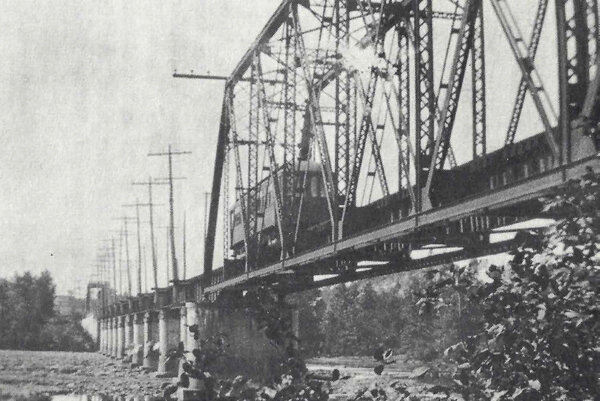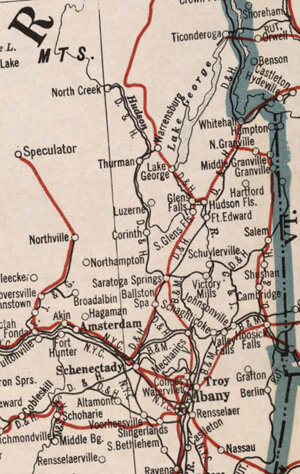Railroad Bridge
Railroad Bridge
Spanning the Hudson River south of the Northumberland Dam are the surviving embankment and piers of an old railroad bridge. The Greenwich and Johnsonville Railway Company built the bridge in 1902 as a part of a seven-mile railway spur to connect the mills and manufacturers in Schuylerville and Greenwich. Eventually, the rail bridge would connect the Thomson Mills, as well as the 20 paper and knitting mills surrounding Schuylerville, with the line to Boston and Maine.
New York State was a pioneer in rail development, completing one of the first rail lines in the United States between Albany and Schenectady in 1831. Soon after, plans were made for a rail line from Boston to Buffalo. Investors saw this as an opportunity for year-round passenger and freight transport. Before the railroads, most commercial travel grinded to a halt in the winter when the canal froze. After the Civil War, when the Hoosac Tunnel was completed, linking the region with the railways of New England and the Boston ports, “railroad fever” was in full swing.
Opened in 1870, the 14-mile Greenwich and Johnsonville Railway ran between the town of Greenwich, on the opposite side of the Hudson River, and Johnsonville, a hamlet on the Hoosic River between the towns of Pittstown and Schaghticoke in Rensselaer County. There it connected to the main line to New England, creating new markets for local goods.
The 1902 rail bridge secured this area’s legacy as a transportation crossroads. After World War II, many of the railways went bankrupt and sold the iron rails for scrap. These remnants of the railroad bridge remind us of the vibrant history and industry Schuylerville enjoyed as a major transportation corridor.
The Boston and Maine Depot Station
on Spring Street (Route 29) in Schuylerville. The tracks were originally laid in 1882 down the middle of Green Street. Photo courtesy of Saratoga Town Historian
Crossing the Greenwich and Johnsonville trestle
between Thomson and Northumberland. From the collection of Darryl Dumas
This rail bridge over Fish Creek
is an example of what the bridge over the Hudson River looked like. Courtesy of New York State Archives
Detail of Railroad & Auto Map,
New York, New Jersey and Pennsylvania by C.S. Hammond & Company. Courtesy of the Library of Congress






